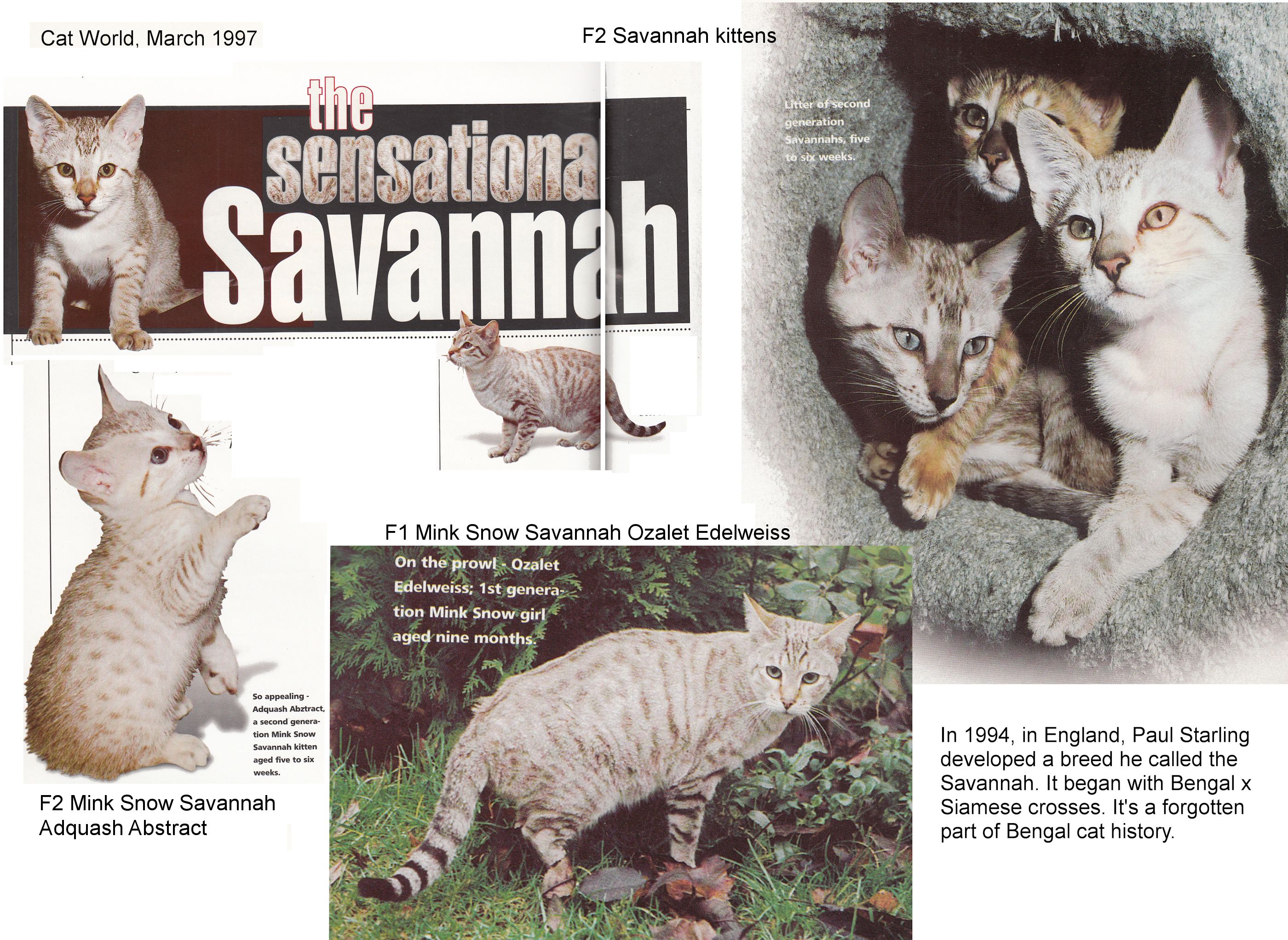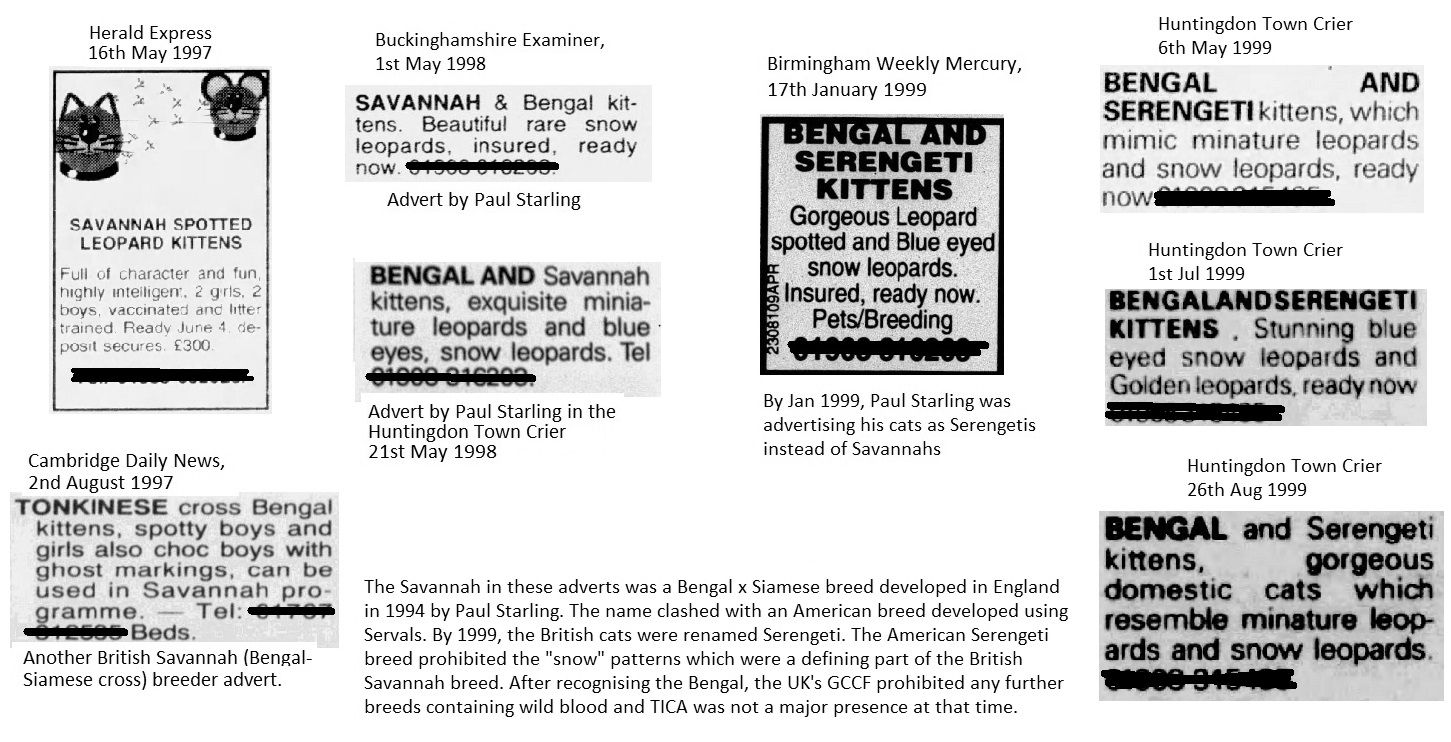
LOST BREEDS - THE BRITISH SAVANNAH (1994) AND THE BENGAL-SIAMESE CROSSES
Most present day Bengal breeders are unaware of the secret Siamese ancestry of some Bengal lines. This mostly came from breeders wanting to improve the blue eye colour of the “snow” varieties of Bengal. A lost British breed, first developed in 1994, called Savannah (which is unrelated to the modern Savannah developed in the USA) is probably linked to those outcrossings.
This is from Cat World, March 1997 and deserves a wider audience as many modern Bengal breeders are unaware of the Bengal-Siamese crosses. The breed – called Savannah – is not the same as the serval-derived breed now bearing that name, nor is it the same as the Serengeti cat developed in the USA in 1994. The British Savannah breed didn’t take off and it’s likely the cats were absorbed back into the Bengal gene pool as Experimental Shorthairs.
THE SENSATIONAL SAVANNAH
Cat World, March 1997.
Feline fanciers could ask: ‘Do we really need one more breed of cat?’ Paul and Carrie Starling, enraptured by the sight of a solitary Siamese said ‘Yes’ and took it from there...
The Savannah Cat would not exist today if it were not for a totally unrelated incident which took place during August 1990. While on holiday in North Wales, we took a ride on the Great Orme Tramway. During the journey my wife noticed a large Siamese cat being taken for his daily walk on a lead. The cat looked so regal and dignified that my wife immediately decided that she must have one of these cats, and so, a previously non-cat family subsequently became addicted to cats for life. Sure enough, in the spring of the following year Cleo, a blue point Siamese kitten arrived and promptly took over management of the family. It was not long before I noticed a photograph of Gogees Warhawk which appeared in Cat World and I myself was immediately sold on the Bengal Cat. The scene was set for the development of the Savannah Cat; the inevitable happened and our Bengal Snow Leopard boy Flyingwfarms Moonshine, was experimentally mated to a Siamese and an Oriental Spotted Tabby. The first results were disappointing, but being determined, alternative matings were tried and during 1994 a litter of two leopard spotted and three snow leopard kittens were born.

Laska, a blue-eyed snow leopard girl was retained as foundation stock for our proposed new breed. Further matings were tried and a mink snow leopard girl Ozalet Edelweiss and a sorrel leopard spotted Ozalet Honeybelle, were also retained.
Having now gained experience from our experimental matings we were now in a position to assess our results. The first point to become apparent was that the results of first generation matings were unpredictable, from the Siamese side of the mating. All the Siamese used either carried the tabby gene or were Oriental Spotted Tabby carrying the Colourpoint gene, yet one Siamese, Bali (Lerita Valentine) produced by far the best results.
Purely by accident we discovered that Bali had distinct shadow spots under certain lighting conditions, aligned not as is common in some Siamese, in the same pattern as an Oriental Spotted Tabby, but in the same way as the Bengal and the Leopard Cat. We have asked ourselves why should she carry a recessive leopard spot?
The only theory we could find was that as the Siamese originated from Siam (Thailand), where the Leopard Cat Felis Bengalensis is an indigenous wild cat, could it not be conceivable that it played a part in the development of the Royal Cats of Siam and that certain genetic factors are still carried recessively in the present day Siamese? Perhaps this could explain the unique characteristics which set the Siamese apart from other breeds. A controversial theory and food for thought?
By now we felt we were progressing well towards producing our dream cat - a large Siamese type, bearing the Snow Leopard coat pattern and pelt of the Bengal, which, in our opinion looks more like a miniature leopard than anything we had previously seen.
We had been asked ‘Why develop the Savannah Cat while we have the Bengal?’ Apart from the fact that we are producing what we consider to be a very beautiful cat, we have found that potential buyers of Bengal kittens are drawn to Savannahs in preference, being impressed with the lithe body type.
We have a philosophy - 95 per cent of kittens go to pet homes, therefore the reputable cat breeder has a duty to the public to meet their demands, as opposed to breeding solely for recognition on the show bench.
The Savannah has a beautiful temperament, totally devoted to its owner, while still retaining the air of independence of the Bengal.
The Savannah Cat is, at present, by no means perfect. There is much work to be done in the future, together with the development of other colour varieties which are currently under consideration.
Paul and Carrie Starling have just set up the Savannah Cat Club to help take the breed for-ward. You can contact them on [removed]. They now have a nucleus of breeders devoted to the Savannah and preliminary standards are being drawn up.
(As a side note, an F3 Bengal female from Paul Starling, Ozalet Asia, produced longhair kittens, so he had quite a diverse gene pool.)

BENGAL / SIAMESE CROSSES
Delving into the early history of the Bengal in Britain unearths some interesting facts pertinent to the breed in Britain. This is from personal correspondence with an early British breeder. This additional information is provided by private correspondence with an early breeder of Bengals in the UK, 30+ years ago and shed light on the more secret party of Bengal history in the UK. Most of the older breeders have passed away, and others prefer not to mention this part Bengal history, but at least one feels it is important to disclose this before everyone from that time has gone.
First a little background is needed. British legislation that applies to the sale of pedigree animals means that to be sold as a pedigree cat, all cats in the previous 3 generations must have a pedigree, even if they are different breeds. Cats with a “moggy” in the previous 3 generations cannot legally be sold as pedigree cats. This means American-derived breeds whose standard stipulates non-pedigree outcrosses have to follow a different breeding programme in Britain – the law of the land overrides cat fancy rules.
Siamese outcrosses didn’t go down on the Bengal pedigree as Siamese and some may have been registered with TICA as “unknown”. My correspondent knew 4 breeders in the North of England from the 90’s (prefixes not recalled), some in their 70s at the time. One was a lady called Muriel who had bred Siamese for 40+ years and had been breeding Bengal x Siamese for a number of years with a breeder in the South of England. Muriel advertised a “blue eyed snow” (as they were called back then) and my correspondent went to her house to view the cat. The indoor cattery was built up to ceiling level in the alcoves on either side of the chimney breast, with Bengals on one side and Siamese on the other, as well as Bengal-Siamese crosses. My correspondent didn’t buy the advertised male as he was F1 Bengal-Siamese and too Siamese looking for her own breeding programme.
My correspondent later met up with a GCCF breeder named Marion who used Siamese to improve the deep blue eyes of her snow Bengals. The remaining 2 breeders advertised their Bengal-Siamese kittens in “Loot” until they reached TICA’s SBT level 4 generations later, meaning there were never any records of their Siamese ancestry. This ties in with a Bengal x Siamese derived cat that was bred in Britain by one breeder and briefly advertised. This was a large, Siamese-type cat with the pattern of a snow leopard Bengal and deep blue eyes. It was initially called a “Savannah,” but appears to have been renamed in line with the similar American-bred “Serengeti” and to avoid a name clash with the American-bred Savannah (serval x domestic cat). One wonders if this British “Savannah” is part of the “lost” history of the Bengal breed in Britain.
WHAT HAPPENED TO THE BENGAL/SIAMESE SAVANNAH?
In part, it was probably too similar to an American breed called the Serengeti and Paul Starling seemed to have gone down the Serengeti route instead. The Serengeti (bred by Karen Sausman, Kingsmark Cattery, California in 1994) was derived from Bengal x Oriental Shorthair – but not Siamese - with the aim of producing a serval-like domestic cat without adding further wildcat blood. The result was a spotted breed with long legs, a long neck and large, round-tipped ears with black/dark brown spots on tawny or silver background (black smoke and solid black also occurs). The British-bred cats – Bengal x Siamese – were blue-eyed cats combining spots/rosettes and colourpoint.
After the recognition of the Bengal, the GCCF – Britain’s main registry - refused to recognise any more breeds containing even a tiny percentage of wild blood. There were a number of Serengeti cats bred to Bengals but these offspring were “Bengal Variants” if registered with the GCCF and a Bengal mated to a Serengeti was considered a cross-breed. TICA did not have a presence in Britain at that time and the Cat Association was very small compared to the GCCF. Breeders had nowhere to register Bengal-Siamese Savannahs or Bengal-Oriental Shorthair Serengetis.
In Britain, Neverneverland Cattery (Lesley Dart) acquired a breeding group of Bengals from the Paul Starling (Ozalet Cattery) at Milton Keynes at the start of 2009. One of the cats was not a Bengal, but a black/brown spotted Serengeti called Maggie. On Paul’s death, Neverneverland acquired a snow spotted cat called Isis. Isis and Maggie became the foundation of the UK Serengeti breed. One of Maggie’s offspring is a female registered as “Little Fancy Merryn.” Although the Siamese is part of the Oriental breed group, the TICA-registered Serengeti stipulated that the only acceptable first generation cross is Bengal to Oriental Shorthair, not Bengal to Siamese.
One of the late Paul Starling’s cat breeding colleagues was sued in a County Court by a novice breeder who had bought a Bengal-Havana (Chestnut Oriental Shorthair) cross-breed kitten which the vendor had claimed to be a rare new breed that would be lucrative. The plaintiff didn’t win. The cross was equivalent to a Serengeti, but could not be registered as such with the GCCF, indicating a switch from British Savannah to Serengeti.